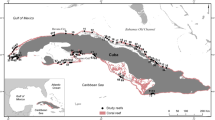Abstract
Analysis of available wind data for the years 1962–80 from Heron Island which is located within the southern Great Barrier Reef indicates that the annual wind energy vector has oscillated within a 45 degree arc from the SSE in the early 1960's to ESE in the late 1970's. Such changes in wind direction influence the direction of propagation of the waves which mould the shape of coral sand cays in this region. Documentation is provided which shows that the variability of the shoreline positions on Erskine Island, an uninhabited vegetated sand cay reflects this change. The implication is that contemporary shoreline erosion on Heron Island is not caused by the development associated with the tourist resort there. It is a symptom of the change in the propagation direction of the wind-induced waves which is related to long-term climatic change.
Similar content being viewed by others
References
Edgell JA (1928) Changes at Masthead Island. Rep Gt Barrier Reef Comm 2:57
Flood PG (1974) Sand movements on Heron Island, a vegetated sand cay, Great Barrier Reef Province, Australia. Proc 2nd Int Coral Reef Symp 2:387–394
Flood PG (1977) Coral cays of the Capricorn and Bunker Groups, Great Barrier Reef Province, Australia. Atoll Res Bull 195:1–7
Flood PG (1979a) Heron Island erosion problems. Reeflections 3:4
Flood PG (1979b) Geomorphology of Tryon Island and Reef. Queensl Nat 22:113–126
Flood PG (1980) Cyclone “Simon” changes cays. Reeflections 6:4
Flood PG (1981) Coral cays and cyclones. Beach Conservation 42:6
Flood PG (1983) Climatically induced changes to the shape of coral cays, southern Great Barrier Reef, Australia. In: Baker JT, Carter RM, Sammarco PW, Stark KP (eds) Proceedings of the Inaugural Great Barrier Reef Conference. JCU Press, Townsville, pp 379–384
Flood PG (1984) Variability of shoreline position on five uninhabited islands of the Capricorn Section, Great Barrier Reef Marine Park. In: Ward WT, Saenger P (eds) The Capric nia Section of the Great Barrier Reef: past, present and future, Royal Society of Queensland and Australian Coral Reef Society, Brisbane, pp 17–24
Flood PG, Jell JS (1977) The effect of cyclone “David” (January 1976) on the sediment distribution patterns on Heron Reef, Great Barrier Reef, Australia. Proc 3rd Int Coral Reef Symp 2:119–125
Gillham ME (1963) Coral cay vegetation, Heron Island, Great Barrier Reef. Proc R Soc Queensl 73:79–92
Gourlay MR (1983a) Interaction between natural processes and engineering works on the leeward side of a coral cay. A case study of Heron Island on the Great Barrier Reef. Proceedings of the International Conference on Coastal and Port Engineering in Developing Countries, Coiombo, pp 1468–1482
Gourlay MR (1983b) Accretion and erosion of coral cays and some implications for the management of Marine Parks. In: Baker JT, Carter RM, Sammarco PW, Stark KP (eds) Proceedings of the Inaugural Great Barrier Reef Conference. JCU Press, Townsville, pp 475–482
Gourlay MR, Flood PG (1981) Impact of coastal engineering works upon a coral cay: Heron Island. Conference on Environmental Engineering 1981. Institute of Engineers, Australia, pp 159–163
O'Keeffe P (1979) Beaches on coral cays. Beach Conservation 37:2–4
Pittock AB (1973) Global, meridional interactions in the stratosphere and troposphere. Q J R Meteorol Soc 99:424–437
Steers JA (1938) Detailed notes on the islands surveyed and examined by the Geographical Expedition to the Great Barrier Reef in 1936. Rep Gt Barrier Reef Comm 4:51–96
Stoddart DR, Steers JA (1977) The nature and origin of coral reef islands. In: Jones OA, Endean R (eds) Biology and geology of coral reefs 4 Geology 2. Academic, New York, pp 59–105
Stoddart DR, McLean RF, Hopley D (1978) Geomorphology of reef islands, nothern Great Barrier Reef. Philos Trans R Soc London Ser B 284:39–61
Taylor J (1924) Movement of sand cays. Queensl Geograph J 39:38–39
Thom BG (1978) Coastal sand deposition in southeast Australia during the Holocene. In: Davies J, Williams MAJ (eds) Landform evolution in Australia. ANU, Canberra, pp 197–214
Thom BG, Roy PS (1985) Relative sea levels and coastal sedimentation in southeast Australia in the Holocene. J Sediment Petrol 55:257–264
Umbgrove JHF (1947) Coral reefs of the East Indies. Geol Soc Am Bull 58:729–777
Verstappen H Th (1954) The influence of climatic change on the formation of coral islands. Am J Sci 252:428–435
Ward WT, Russel JS (1980) Winds in southeast Queensland and rain in Australia and their possible long-term relationship with sunspot number. Climate Change 3:89–104
Ward WT (1982) Formation and development of the shoreline near Tangalooma Point, Moreton Island. Proc R Soc Queensl 93:11–20
Author information
Authors and Affiliations
Rights and permissions
About this article
Cite this article
Flood, P.G. Sensitivity of coral cays to climatic variations, southern Great Barrier Reef, Australia. Coral Reefs 5, 13–18 (1986). https://doi.org/10.1007/BF00302166
Accepted:
Issue Date:
DOI: https://doi.org/10.1007/BF00302166




